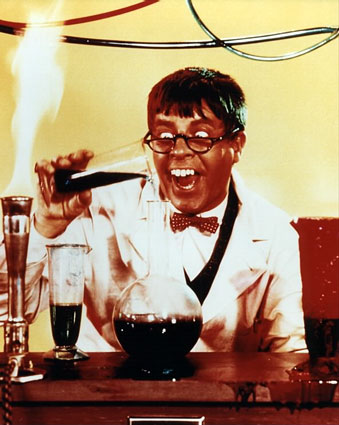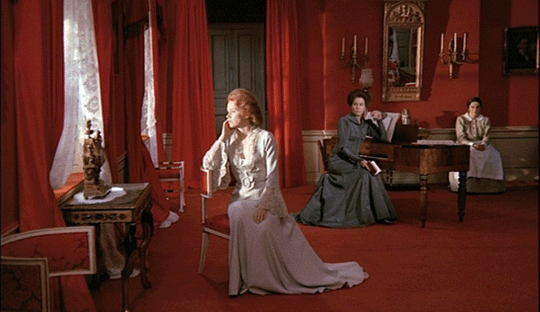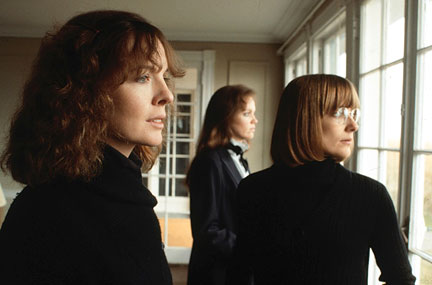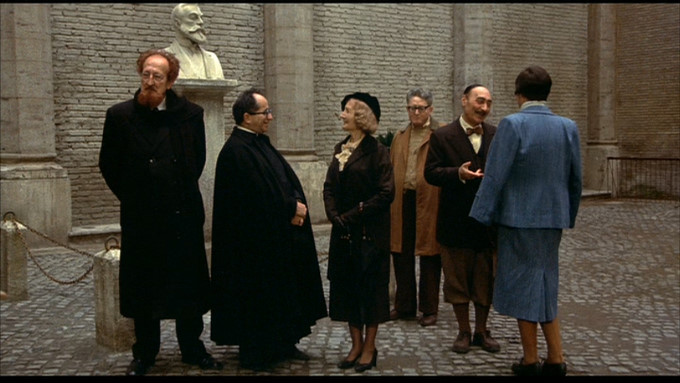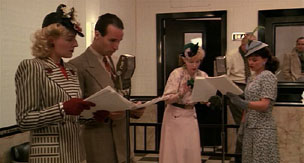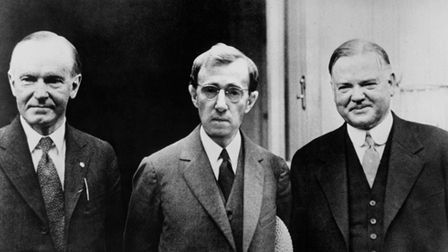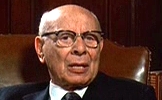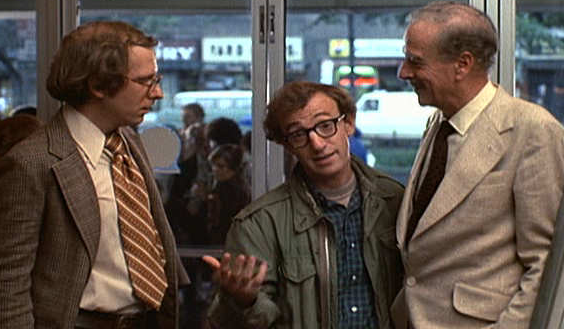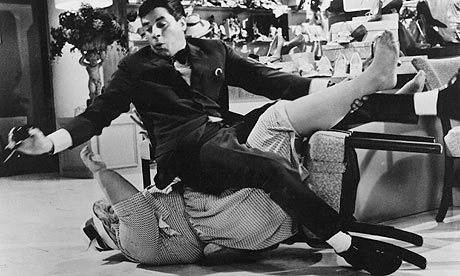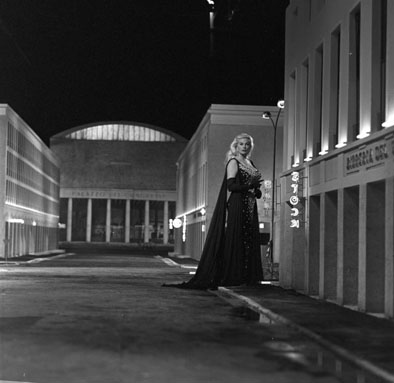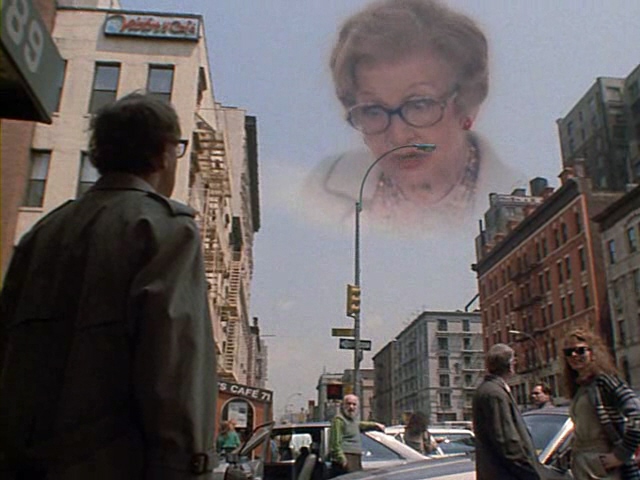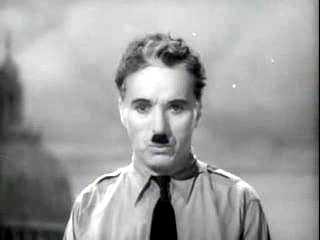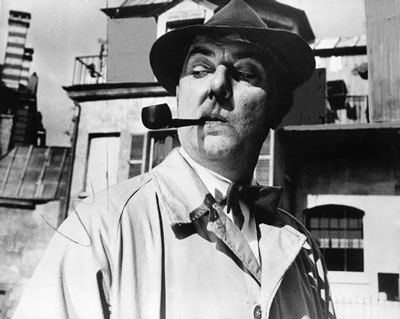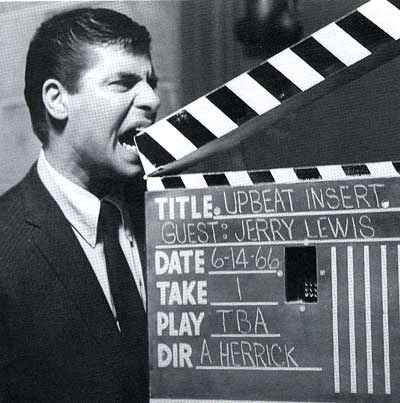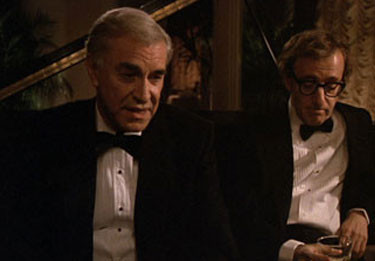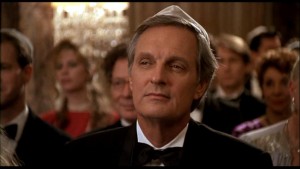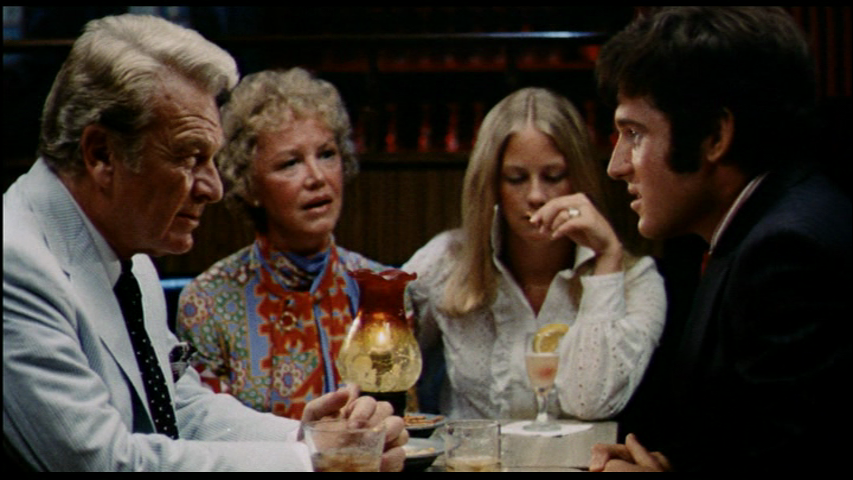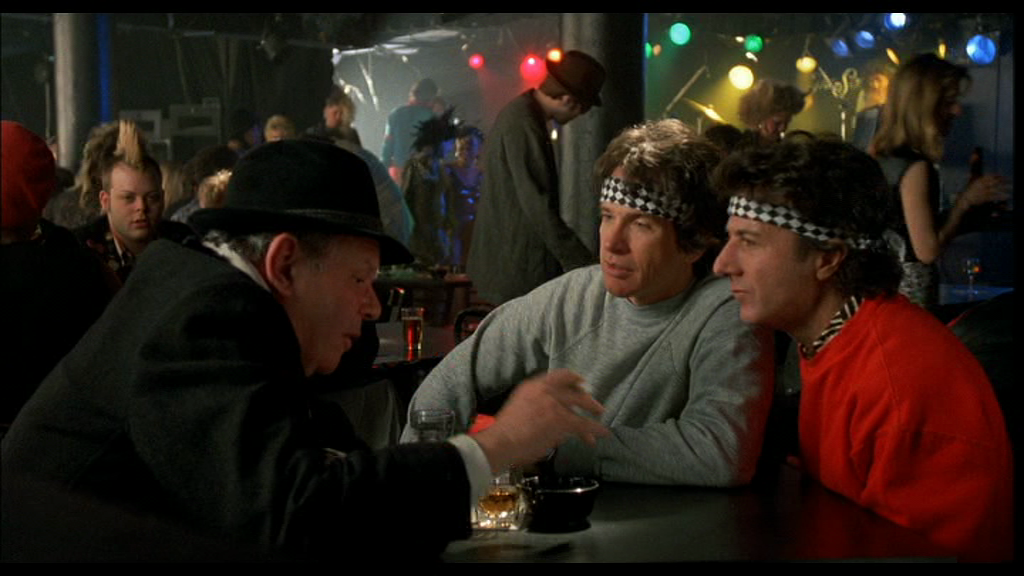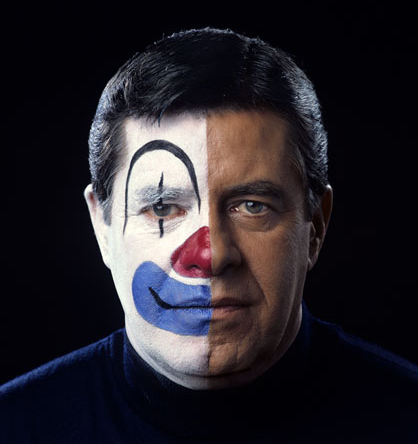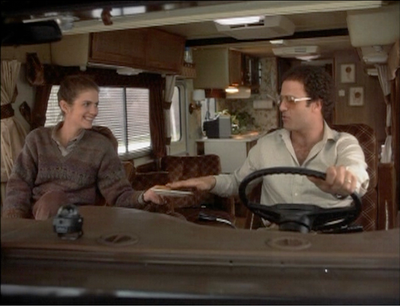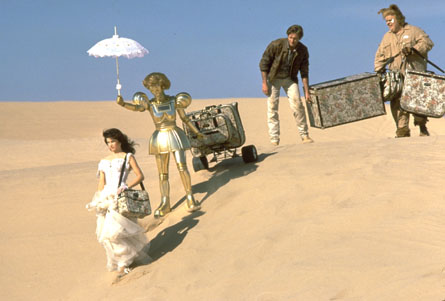This appeared originally in the May-June 1990 issue of Tikkun, and was reprinted in my first collection, Placing Movies: The Practice of Film Criticism, five years later. — J.R.
“Why are the French so crazy about Jerry Lewis?” is a recurring question posed by film buffs in the United States, but, sad to say, it is almost invariably asked rhetorically. When Dick Cavett tried it out several years ago on Jean-Luc Godard, one of Lewis’s biggest defenders, it quickly became apparent that Cavett had no interest in hearing an answer, and he immediately changed the subject as soon as Godard began to provide one. Nevertheless it’s a question worth posing seriously, along with a few related ones — even at the risk of courting disbelief and giving offense.
Why are American intellectuals so contemptuous of Jerry Lewis and so crazy about Woody Allen? Apart from such obvious differences as the fact that Allen cites Kierkegaard and Lewis doesn’t, what is it that gives Allen such an exalted cultural status in this country, and Lewis virtually no cultural status at all? (Charlie Chaplin cited Schopenhauer in MONSIEUR VERDOUX, but surely that isn’t the reason why we continue to honor him.) If we agree that there’s more to intellectual legitimacy than name-dropping, what is it in Allen’s work as a comic Jewish writer-director-performer that earns him that legitimacy — a legitimacy that is denied to, among others, Elaine May and both Mel and Albert Brooks?
The issue isn’t simply one of respect, but one of identification and outright infatuation. The implication is that a good many of Allen’s fans view his comic persona in very much the same way that they like to view themselves. If movies in general owe much of their appeal to their capacity to function as Narcissus pools, offering glamorous and streamlined identification figures to authenticate our most treasured self-images, film comedy tends to heighten this tendency in physical terms, so that it would hardly be an exaggeration to state that how we respond to such figures as Chaplin, Buster Keaton, Harry Langdon, Harold Lloyd, Jacques Taft, Lewis, and Allen has something to do with how we feel about our own bodies.
As a comic writer, Allen is easily the equal of Robert Benchley, George S. Kaufman, and S. J. Perelman, and conceivably within hailing distance of James Thurber. As a performer, it is largely his lack of actorly presence — his badge of authenticity — that endears him to the world at large. His self-hatred and lack of physicality may make him an unlikely love object, yet nothing is more reassuring about his persona than the acute sense of failure that he brings to every activity, making every small victory, every flicker of warmth or hope into an inspirational triumph.
As a writer-performer-persona, he is probably as personal as it is possible for someone in his position to be. But as a director and filmmaker, even after nineteen features, he remains strangely unformed and unrealized — not a creator of forms or even a distinctive stylist who can exist independently of his models. This can be seen not only in his use of Sven Nykvist, Ingmar Bergman’s cinematographer, on several of his pictures (usually to create a clinically antiseptic look that evokes Scandinavian seriousness), but also in the visible derivations of Bergman’s CRIES AND WHISPERS in INTERIORS, SMILES OF A SUMMER NIGHT, A MIDSUMMER NIGHT’S SEX COMEDY, and WILD STRAWBERRIES in ANOTHER WOMAN; of Fellini’s 8 1/2 in STARDUST MEMORIES and AMARCORD in RADIO DAYS; and of Fellini’s episode in BOCCACCIO ’70 in Allen’s episode (OEDIPUS WRECKS) in NEW YORK STORIES, among other examples. Even in ZELIG, one of his more original conceptions, the periodic statements by Jewish intellectuals playing themselves — Saul Bellow, Bruno Bettelheim, Irving Howe, Susan Sontag — are used in a way that makes them clearly indebted to the statements of the “witnesses” in Warren Beatty’s REDS, which was released two years earlier. (The validation of ZELIG’s fictional world offered by “real” intellectual celebrities, paralleled by the appearance of Marshall McLuhan in ANNIE HALL, is of course quite different from the dialectical function of the witnesses in REDS, who remain unidentified, but the appropriation of Beatty’s technique is again characteristic.)
Most often these borrowings, when they’re noticed, are rationalized in the press as “homages”; yet arguably they reveal the same sort of aesthetic immaturity that a beginning writer shows by imitating, say, Hemingway or Faulkner. Imitation can be a sincere form of flattery, and there’s no doubting the sincerity of Allen’s Bergman and Fellini worship. But beyond a certain point there’s a question of whether this kind of emulation is being used as a tool for fresh discoveries or as an expedient substitute for such discoveries — a shield labeled “Art” that’s intended to intimidate nonbelievers.
There’s a world of difference between the application of film models by a Jean-Luc Godard or a Jacques Rivette, which offers critical insights into a particular film or director (such as the compressed references to MONSIEUR VERDOUX and PSYCHO in Godard’s WEEKEND, which point up the links made between murder and capitalism in both earlier films), and the simple transposition of a look or manner employed by Allen. Perhaps if Allen’s cinematic frames of reference were wider — taking in, say, Carl Dreyer as well as Bergman, and Roberto Rossellini as well as Fellini — his appropriations might not seem so willful and automatic. One reason why Rivette’s creative uses of Fritz Lang and Jean Renoir seem much more fruitful is that neither of these filmmakers is tied exclusively to a single country or culture. The styles of Bergman and Fellini, by contrast, are linked indigenously to the respective cultures of Sweden and Italy, so what point is there in transposing these styles to an exclusively New York milieu? Yet Allen is often treated in the press as if he were even more important than the directors he copies.
In an illuminating book about film editing called When the Shooting Stops. . .the Cutting Begins, Ralph Rosenblum describes in detail how he substantially reworked Allen’s unformed and scattershot rough cuts on half a dozen early features — even successfully demanding that Allen shoot new endings to TAKE THE MONEY AND RUN, BANANAS, SLEEPER, and LOVE AND DEATH, and transforming a self-centered smorgasbord called ANHEDONIA (“the inability to experience pleasure”) into a graceful romantic comedy called ANNIE HALL. Although Rosenblum no longer edits Allen’s pictures, perhaps as a consequence of writing this book, Thierry de Navacelle’s more recent Woody Allen on Location, a diary of the shooting of RADIO DAYS which includes in parallel columns the original script and the first “cutting continuity,” amply shows that as recently as 1987 there was still a yawning abyss between Allen’s conceptions and what wound up on the screen. Part of this appears to be a judicious pruning of compulsive morbidity: TAKE THE MONEY AND RUN originally ended with the bloody annihilation of its hero, whereas RADIO DAYS originally began with awkward radio coverage of the drowning of a Houdini type in an underwater stunt. But an equally important part of the problem seems to be that Allen usually starts with a literary conception rather than a filmic one. As he pointed out to Godard in a videotaped interview conducted in 1986, he regards the intertitles in HANNAH AND HER SISTERS as a literary device (as words), whereas Godard uses them in his own films as a cinematic device (as shots).
Obviously there’s nothing wrong with this in itself; the American literary cinema has few sustained talents to call its own, and there’s no doubt Allen’s talents as a writer enhance that cinema in certain respects. Nor can Allen really be blamed for the inordinate claims made for his movies by Vincent Canby and others; his own remarks about his pictures tend to be much more modest. One also respects his passion and seriousness in speaking out against colorization and his refusal to let his only film in CinemaScope, MANHATTAN, be scaled down to the ratio of the television screen by losing its left and right borders — something that neither Bernardo Bertolucci nor Steven Spielberg has been able to accomplish with the video and television versions of THE LAST EMPEROR and EMPIRE OF THE SUN, for example.
But one still needs to ask why Allen has been nominated and all but elected our foremost “artistic” filmmaker and the poet laureate of our collective uncertainties in so many circles, most of them upscale and middlebrow. What does he do for this audience that is deemed so essential and irreplaceable? To what extent is his stature a progressive factor in our film culture, and to what extent is it reactionary? How much does his status as an intellectual filmmaker represent genuine intellectual inquiry, and how much does it suggest something closer to the reverse — a representation of intellectuals for nonintellectuals and even anti-intellectuals that serves to satisfy curiosity about intellectual concerns without any sort of intellectual challenge?
Why are the French so crazy about Jerry Lewis? Well, for one thing, some of them see him as being very much like America: infantile, hysterical, uncontrolled, giddy, uninhibited, tacky, energetic, inarticulate, obnoxious, sentimental, overbearing, socially and sexually maladjusted, and all over the place. (By contrast, at least on the surface, Allen is adolescent, neurotic, controlled, whiny, inhibited, preppy, lethargic, articulate, cynical, wormy, socially and sexually maladjusted, and confined.) It’s not so much a matter of necessarily loving all these qualities as it is envying or admiring or identifying with some of them, and being horrified by others — a sort of compressed model of the love-hate that many French people feel toward America as a fantasy object. I suspect that what many French people experience as the overcultivated constraints of their culture finds a welcome release in Lewis’s explosiveness and ungainliness, and their taste for freewheeling fantasy is partially met by Lewis’s remoteness from realism — the sheer wildness of his ideas as a writer-director, and the deconstructive habits such as the vulgar modernism that he shares with Mel Brooks, which periodically reminds us in various self-referential ways that we’re watching a film. (At one point in the mid-1960s, Godard described Lewis as “the only free man working in Hollywood.”)
None of this, however, should be regarded as monolithic or exclusive regarding French tastes: the French also happen to be crazy about Woody Allen. But it’s worth remarking that the French are less prone than we are to regard Allen as any sort of improvement on or substitute for European art-film directors. The essence of any taste is largely a matter of what it excludes as well as what it includes, and the ascendancy of Woody Allen as an art-film director in the United States coincides with a steady drop in interest in foreign-language art films. We can count on every Allen film being readily available in one form or another all over the United States, but not every film by Bergman or Fellini (whose last feature, INTERVISTA, has never been released here); in the cases of Antonioni, Godard, and Alain Resnals, most of their last several films remain unavailable in the United States.
Allen is far from being the only comic director who thinks verbally more than visually; the same is true of Mel Brooks, and an overall orientation toward the word rather than the image may have something to do with the nature of Judaism as an oral culture. When someone in Brooks’s HISTORY OF THE WORLD, PART I remarks, “The streets are crawling with soldiers,” one knows in advance that Brooks will have to follow this with a non sequitur visual equivalent — giving the word and voice primacy, literally making it flesh by spelling it out in rebus form. “Death was greeted with a certain amount of awe,” intones narrator Orson Welles near the start of the same film, and everyone standing around in the perfunctory, instantly forgettable shot who isn’t supposed to be a corpse goes “Awwwww — .” Saying as well as spraying it, chewing and spewing words until they overspill and start to fill in some of the cracks left by the illustrative images, Brooks’s characters and their shticks go much farther into literalism than Allen’s do, to the degree that they often make consecutive, coherent narratives impossible, adhering to the more freeform structures of standup routines. (For the record, Allen’s uncharacteristic first feature in 1966, WHAT’S UP, TIGER LILY?, was as wild and deconstructive as anything by Brooks or Lewis.)
Allen, by contrast, depends mainly on stories with naturalistic underpinnings; whatever the stylistic varnish given to any particular film, the form more often than not is relatively conventional (which helps to account for what makes his movies relatively accessible). But Allen’s heroes remain fundamentally standup personalities, and what is most often funny about them is their wisecracks. This tendency is tied, in any case, to the increasing formal problem in Allen’s work of integrating his comic, actorly persona with his more serious aspirations as a narrative filmmaker. His last several comic films have proposed different solutions for injecting Woody into a plot: incorporating him into mock newsreels (and uncharacteristically depriving him of a voice) in ZELIG, bringing him back as a sympathetic romantic hero in BROADWAY DANNY ROSE and as a Kafkaesque hero in OEDIPUS WRECKS (in NEW YORK STORIES), using Mia Farrow as a partial Woody substitute in both THE PURPLE ROSE OF CAIRO and RADIO DAYS, using Dianne Wiest as a female Woody in HANNAH AND HER SISTERS and RADIO DAYS, and isolating him like a bacteria in the parallel plots of both HANNAH AND HER SISTERS and CRIMES AND MISDEMEANORS.
A better sense of how Allen handles these problems of language and persona can be deduced by comparing his strategies with those of Chaplin, Tati, and Lewis. For Chaplin, speech brings about a transformation of the Tramp at the end of THE GREAT DICTATOR, and then his elimination from all the subsequent films. Tati’s Monsieur Hulot, initially designed to appear only in MR. HULOT’S HOLIDAY, is furnished with a wealthy sister and nephew in MON ONCLE, multiplied and universalized by various lookalikes (to prove that we are all potential Hulots) in PLAYTIME, brought back in desperation as the central hero of TRAFIC after the commercial disaster of the former film, and finally abandoned with relief in PARADE. In all these films, speech is overheard more than heard, and sound is generally used to complement and punctuate (rather than illustrate) the images. Lewis in his own films — although doing little to alter his character (apart from adjusting to the effects of aging) — accompanies his bodily deformations with deformations of language, creating a kind of spastic Jabberwocky at moments of hysteria to reflect his gangling physical instability.
Like Allen, these figures can be regarded as autobiographical artists in the deepest sense, their gags springing directly from their own lives and experiences. (This might seem less obvious with Lewis, but it’s worth noting that his last feature, CRACKING UP, has slapstick sequences alluding to both his open-heart surgery and his near-suicide.) All three can also be said to be animated by a conflict between narcissism and self-hatred in relation to their comic personae. Where they differ crucially from Allen is in the degree to which they express this conflict dialectically. Rather than work both sides of the street, as Allen does, they usually maintain enough distance from their own characters to allow audiences to have a critical perspective on them. Allen, by contrast, is too close to Woody to allow us this detachment; his task is to seduce us into sharing his character’s confusions and ambivalences without being able to sort them out. (After all, Woody can’t sort them out, so why should we?) And rather than propose an artistic solution to a personal conflict as Chaplin, Taft, or Lewis do, he offers a kind of aesthetic smoke screen designed to keep us from realizing that the conflict isn’t being squarely faced.
Intellectuals and anti-intellectuals, liberals and conservatives, can all walk away from Allen’s movies feeling that their own worldviews have been corroborated and illustrated because no issue is ever forced to a point of crisis — a few potshots in every possible direction usually suffice. The gag in ANNIE HALL about Dissent and Commentary merging into Dysentery has something for everybody: readers of both journals feel grateful for this uncharacteristic form of recognition in a commercial movie; people who feel distaste for the intellectualism associated with both publications are rewarded; and even those who might bristle at the political incompatibility of the two magazines are likely to be amused by the pun.
CRIMES AND MISDEMEANORS offers another case in point. A film that professes to address the rampant amorality and self-interest of the 1980s gives us an ophthalmologist (Martin Landau) who arranges to murder his mistress and gets away with it and a socially concerned documentary filmmaker (Allen) who isn’t rewarded for his good intentions. But both characters seem equally motivated by self-interest, and we are asked to care much more about Allen’s character as a fall guy than about the murdered mistress (Anjelica Huston). Landau’s masochism about his initial feelings of guilt are matched by Allen’s masochism about being a loser. There is a lack of ironic distance on this aspect of both characters, and if the film is genuinely attacking self-interest, it is seriously handicapped by being unable to see beyond it.
A major distinction here is social context. Chaplin and Tati offer characters whose main problem is coping with the world; Lewis and Allen’s characters, however, are concerned with both coping and scoring, and the importance of scoring — greater in Allen’s case than in Lewis’s — implies a different relationship to the society in question. Scoring is the aim of the extrovert hungering for society’s approval and applause; and for all their apparent maladjustments, Allen’s heroes already belong fully and integrally to the society they wish to succeed in. They never suggest total outcasts, as Lewis’s heroes often do.
One thing that makes both Chaplin and Tati profound social critics is the fact that their characters’ difficulties in coping with society lead to a consideration of society’s difficulties in coping with them. Lewis carries over some of this process (see, for instance, THE NUTTY PROFESSOR), but Allen virtually abandons it. Apart from the loving self-deprecations, and the daring jibes against his audiences in STARDUST MEMORIES, his social critique seldom gets beyond the range of one-liners, whereas the obsession with success and scoring usually implies that it is the oddball individual and not the society that needs to make adjustments.
One of the most disturbing facts about contemporary American life is its rejection of the concept of victims; the current synonym for “victim” is “loser.” When Allen’s character in CRIMES AND MISDEMEANORS is listening to his sister describe her humiliation at the hands of a sadist after answering a classified ad, Allen’s horrified responses are telegraphed to the audience as invitations to cruel and derisive laughter, not pity. This is a curious ploy in a film that professes to be protesting the erosion of moral and ethical values, but one that is consistent with Allen’s usual methods, because it’s much easier to laugh at a loser than at a victim.
Evenly matching the dichotomy between Winners and Losers in Allen’s films is the dichotomy between Insiders and Outsiders. Allen generally places one foot in each camp — looking with contempt at Insiders (Alan Alda’s television producer in CRIMES AND MISDEMEANORS) from an Outsider’s position, but also looking with contempt at Outsiders (the movie fans in STARDUST MEMORIES) from a privileged Insider’s position. In RADIO DAYS, the warm superiority assumed by the narrator (Woody again) toward his family and the abject inferiority felt by Sally (Mia Farrow) toward radio stars (before she becomes one herself) are cut from the same cloth. Suffusing both realms with nostalgia while taking swipes at each side from the other, Allen refuses to commit himself wholly to either group or even to own up to that refusal — a decision that would shape and delimit the scope of his gags and allow them to work together. By shifting allegiances, he can make all the characters lovable or fair game whenever he wants. A higher laugh quotient is attained by this process, but a much fuzzier moral perspective, because complacent vanity and a lack of commitment to either faction become the prerequisites for such a position. A generous reading of this trait would be to call it a form of objectivity; a more skeptical response would be to regard it as opportunistic.
It’s been noted more than once that part of what makes the Manhattan in MANHATTAN so “attractive” — apart from strains of Gershwin and black-and-white CinemaScope views of favorite spots and haunts — is the nearly total absence of blacks and Hispanics. Insofar as this is the Manhattan that a certain class of whites already “see,” or want to see, MANHATTAN both validates and romanticizes this highly selective view of the city.
Poverty in Allen’s films, apart from the occasional one-liner, is almost invariably Jewish poverty and is rooted somewhere in the past; the contemporary plight of the homeless, for instance, may be apparent to anyone who walks for a couple of blocks in Manhattan, but it is not apparent in the urban exteriors of ANOTHER WOMAN, OEDIPUS WRECKS, or CRIMES AND MISDEMEANORS, and neither is the presence of racism. All of Allen’s major characters are protected from such problems by the interiority of their concerns, and by implication the audiences of these films are similarly protected. Serious soul-searching about major world problems and the decline in moral values is the exclusive property of a few upwardly mobile urban whites, whose exclusive vantage points we are invited to share, and any set of assumptions that is located beyond the purview of The New Yorker or The New York Times is bound to be deemed both esoteric and provincial.
Robert Warshow’s critique of The New Yorker as a cultural institution (in “E. B. White and The New Yorker“) seems particularly relevant to the nature of Allen’s special appeal:
“The New Yorker has always dealt with experience not by trying to understand it but by prescribing the attitude to be adopted toward it. This makes it possible to feel intelligent without thinking, and it is a way of making everything tolerable, for the assumption of a suitable attitude toward experience can give one the illusion of having dealt with it adequately. The gracelessness of capitalism becomes an entirely external phenomenon, a spectacle that one can observe without being touched — above all, without really feeling threatened. Even one’s own incompetence becomes pleasant: to be baffled by a machine or by a domestic worker or an idea is the badge of membership in the civilized and humane minority.”
I’m willing to accept on faith Allen’s claim in “Random Reflections of a Second-Rate Mind” (Tikkun, January/February 1990) that his reputation as a “self-hating Jew” may be somewhat displaced. (“[W]hile it’s true I am Jewish and I don’t like myself very much, it’s not because of my persuasion.”) But because of the autobiographical elements in his work, it is still difficult to account for the strong relationship between scoring and winning the love of a beautiful WASP woman (usually Diane Keaton or Mia Farrow) in most of his film comedies — although, to be fair about this, his persona does wind up with a Jewish woman just like his (dreaded) mom at the end of OEDIPUS WRECKS. What seems more problematic is the failure of most of Allen’s films to face this issue squarely — to the degree that Elaine May’s THE HEARTBREAK KID does, for instance, when the Jewish hero (Charles Grodin) ditches his Jewish wife (Jeannie Berlin) during their honeymoon in Miami in order to chase after Cybill Shepherd. The fact that in this case May is directing a Neil Simon script (based on a Bruce Jay Friedman story) which never alludes to the ethnic nature of the conflict in the dialogue makes her success all the more striking: to put it bluntly, May’s direction of the actors repeatedly and even uncomfortably exposes the degree to which Grodin’s libido is affected by his own anti-Semitism. Allen’s hero in OEDIPUS WRECKS may have changed his name from Millstein to Mills, and it’s clear that he’s dating a shiksa, but these are merely givens in the plot — the conflict is never explored in psychological terms, either in the dialogue or the direction, and eventually it gets resolved sentimentally when the plot offers him a Jewish girlfriend to replace the shiksa.
The usual reluctance of Allen to alienate his constituency — with notable and courageous exceptions, such as STARDUST MEMORIES and his op-ed piece in The New York Times criticizing Israeli soldiers — generally mean an avoidance of controversial issues and positions in his movies, in spite of their topical gloss. This is, of course, typical of the commercial American cinema, and it might be added that Allen’s popularity with American intellectuals does not automatically mean success at the box office. (Interestingly enough, CRIMES AND MISDEMEANORS has been a commercial disappointment in spite of its rave reviews, and there have been many other such instances in Allen’s career.) His unusual freedom to go on making personal films of his own choosing clearly has a price tag attached to it — the necessity of turning enough of a profit on some pictures to keep this arrangement going — and it would be naive to assume otherwise. Allen’s representation of himself as an artist and an intellectual (as opposed to a “mere” entertainer) obliges us to take him at his own word; and once we do, the issue of what intellectuals and artists both are and should be in our culture immediately comes up. To exempt Allen from that issue is to accept the sort of imposture that the film industry itself is famous for — the notion that art is a form of entertainment that makes money, and that “intellectual” is just a synonym for “pseudo-intellectual.”
Noam Chomsky has written, “It is the responsibility of intellectuals to speak the truth and to expose lies. This, at least, may seem enough of a truism to pass without comment. Not so, however. For the modem intellectual, it is not at all obvious.” Whether or not we regard Allen as an intellectual depends, in the final analysis, on whether or not we accept Chomsky’s view of what should be obvious.
So if we want to see a comedy that tells us something about, say, American idiocy in blundering through the Third World and the Reaganite equation of entertainment and politics, a disreputable piece of goods like Elaine May’s ISHTAR will actually come closer to the mark than any movie we can expect to get from Woody Allen. (The notion of a show-biz agent negotiating a peace settlement in the Middle East as part of an entertainment deal might get by as a one-liner in an Allen effort, but only May would have the nerve to use it integrally, as a resolution of her plot.) If we want to learn some of the truth about unemployment in the United States in the early eighties— a revelation that might make us shudder as well as laugh — Jerry Lewis’s HARDLY WORKING is a better place to go than any film by Allen, just as even a wobbly Mel Brooks effort like SPACEBALLS has more to say about the mercantilism of the film industry than anything we could expect from Woody. Similarly, for a genuinely satirical treatment of blinkered Yuppie sensibilities, one must repair to Albert Brooks’s LOST IN AMERICA, not to HANNAH AND HER SISTERS or CRIMES AND MISDEMEANORS. By contrast, what we find in Allen’s movies, apart from a lively stream of patter, is flattery to our egos as right-thinking individuals and a kind of soul-searching that excludes any possibility of social change — a provincial narcissism that corresponds precisely to our present situation in relation to the rest of the world.

